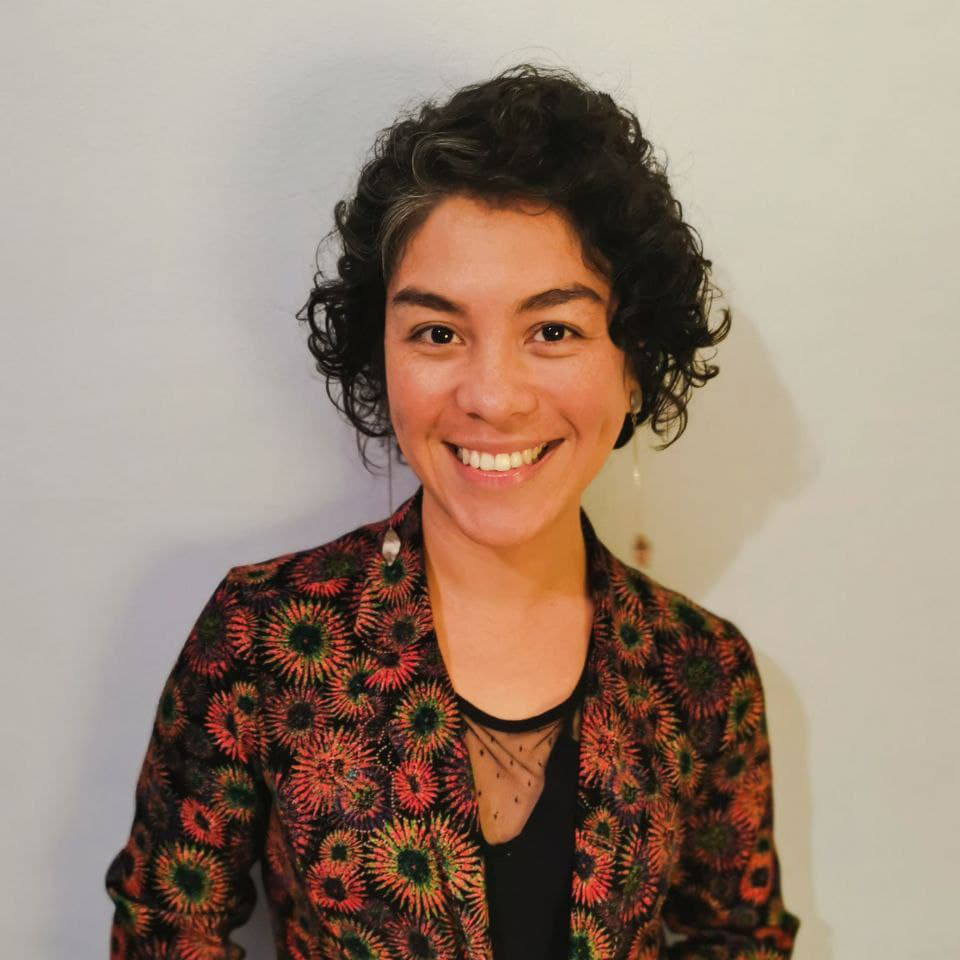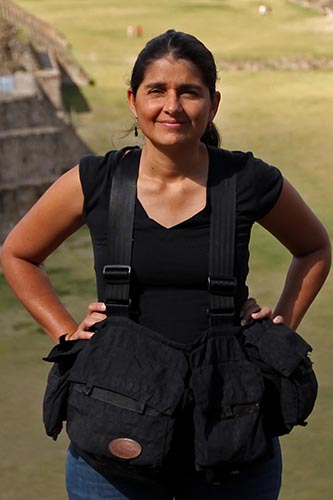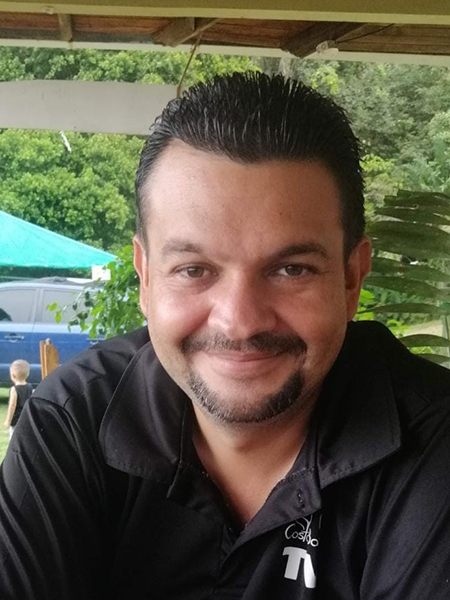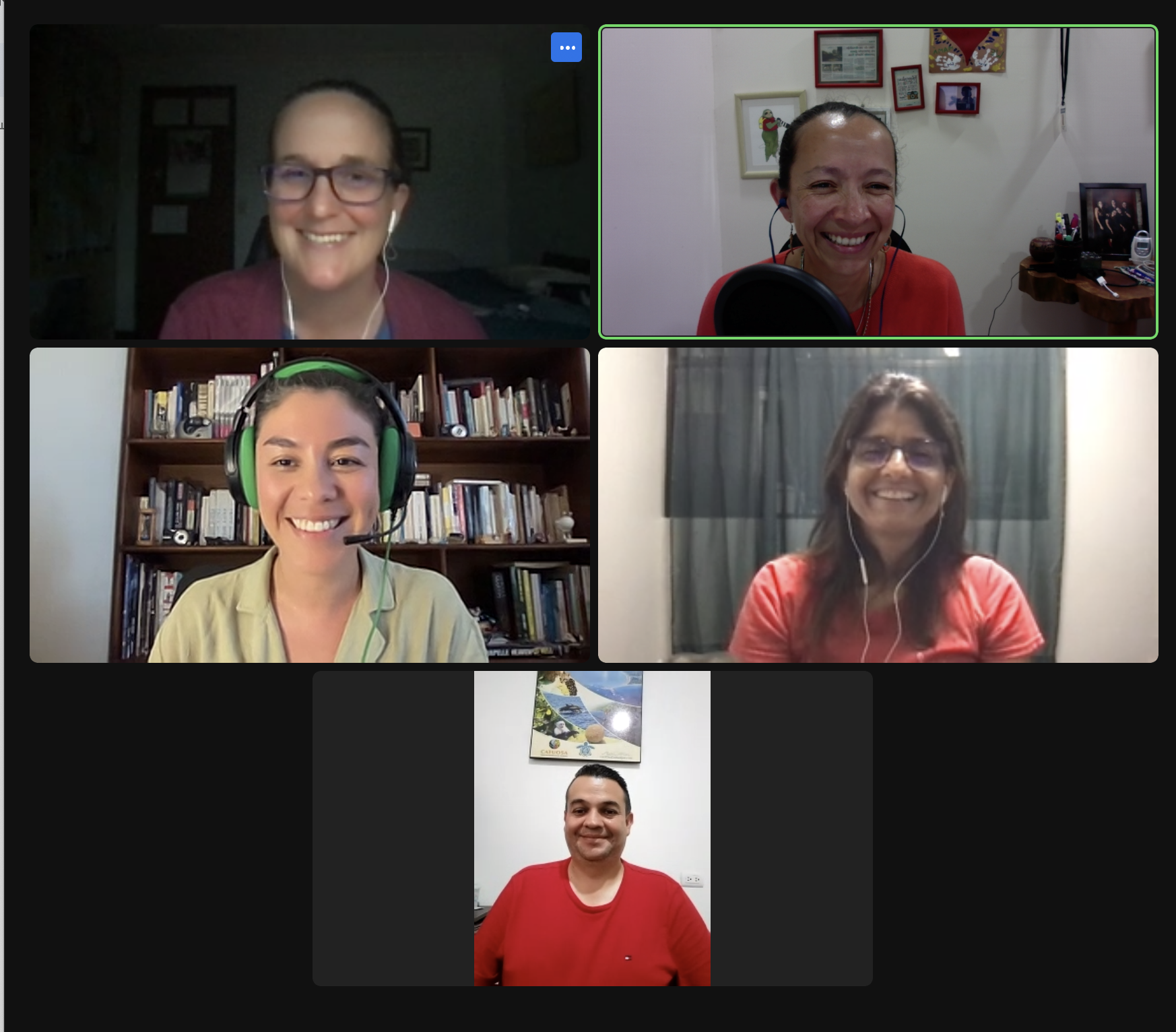The following is an adapted English translation of an episode of the podcast El Colectivo 506, “La onda expansiva inicia con los periodistas” (“The ripple effect starts with journalists”) recorded in Spanish in November 2023. Participants’ comments have been edited for clarity and brevity.
“I’m going to confess something I’ve never said before,” says Sharon.
“On the record or off the record?” I ask.
“On or off, it doesn’t matter!”
All the journalists on the Zoom call laugh. Reporters are like that. When we get together to talk openly about our work, jokes abound. But sometimes we laugh so as not to cry, because those of us who have stuck with our profession have seen many colleagues leave—and not just because of poor pay or layoffs. Journalists are also leaving because journalism is increasingly discredited, in Costa Rica and in many countries, and because the tasks we have to do to stay afloat sometimes take us far away from what attracted us to the field.
Why does it matter? Because when journalists leave, journalism is weakened. We see the consequences of that weakening all around us, every day. The rise in fake news creates an increasingly toxic environment on social media. It affects the quality of public discourse and the people who go to the polls, armed with accurate information or not.
That’s why, at El Colectivo 506, we have come to the conclusion that if we want to understand the impact of solutions journalism, we must start with the impact it has on the people who practice it. Today on our podcast, we are talking to three journalists who, just like us, did solutions journalism for the first time at El Colectivo 506 over the past three years. What happened to them after reporting with the lens of solutions journalism? Was it worth it? Are they still doing it? What else has changed and why? And could it be that the experience affected them beyond the way they do their reporting?
Meet Sharon, Esteban, and Mayela
One of these journalists took a boat to travel to the island that once housed Costa Rica’s most infamous penitentiary, but is now a national park. Another spent hours— many hours!—trying to understand why a dam that would change the life of his community has not been built. Another spoke with various people throughout Talamanca, visited corners of the Osa Peninsula, and offices of government entities, to learn about the power of organized communities.
They are Sharon García Cavallini, Esteban Calderón, and Mayela López. The trajectories of these three journalists are very different. What they have in common is that, in recent years, they have tried solutions journalism for the first time with us at El Colectivo 506. (Solutions journalism is the rigorous research of the responses that have been applied to the problems that affect us.)
When we got together to ask them if their experience with this type of journalism had affected the way they view their profession, it was Sharon who started the conversation. This University of Costa Rica (UCR) Radio journalist told us that, before working in solutions journalism, she felt frustrated. She felt that the responsibility of causing a change for the better in the issues she covered weighed on her shoulders. The helplessness was affecting her.
Sharon: You’re often left with the question of, “What can I do?… What can I do for these people?” I already did the story, I wrote it, I interviewed them, but hey, I turn off the computer, I make my coffee, and I live my life with my privileges. But then how do you actually do something?
But then there’s solutions journalism. I feel that it has helped me to be more proactive as I talk to people: what we can do to solve it, or what they have done to solve it that has given them very good results? Or that has not worked? Or even, what does the government do and not do—what solutions does the government provide, and what solutions does it not?
It’s been like a breeze that comes and goes. On my show, in my community, almost always now, I close with the question: how can this be replicated in other places? Or what we could do to not be left alone with the problem?
I would love to dedicate more time to [solutions journalism], but I do think that I found a way to, as a human being, not stay limited to what I can do, but rather, in the same conversation, pass the ball, [hear how others are addressing] my concerns.
For me, it has been like fresh water.

Mayela is a photojournalist whose career includes years of collaboration in the newspaper La Nación, and in international agencies including AFP and Reuters, and as a freelancer for a large number of national and international media. She was one of the first journalists to work on solutions journalism with us after we launched in January 2021.
Mayela: Solutions journalism allows something that isn’t possible in day-to-day journalism. You can delve into a topic for several days, do good interviews from all angles… In journalism you always try to answer the five Ws, right? What, who, where, when and why. Here, you go a little further and think, exactly what solutions come next? What are the challenges after this problem? Whether it is a national problem or a community problem, it is so juicy to dive into the solutions.
Then you see how the communities are organized, from the indigenous highlands to the coast or the lowlands, like a chain. How there are anonymous heroes who truly work day by day, with pure love for their communities. It is because of those heroes that Costa Rica has, thank God, a very low death toll when there are floods and other natural events. That’s what’s so amazing. With solutions journalism, you don’t just stay up here with a global issue—you go to the communities, go a little further, and see the solution that the communities create for their problems.
What Mayela said struck a nerve with me. When we founded El Colectivo 506, this wonderful idea that had started to percolate within Katherine, we did it because she had witnessed how Costa Rica’s communities are generating impressive responses are to their problems—but oftentimes, few others know about what they’re doing. Not even inside Costa Rica, much less globally.
Mayela: Exactly. It’s so meaningful to share all that wisdom and learning. And Mónica, you were talking just now about audiences: [solutions journalism] also has the potential to attract more audience members, more listeners. [Some people’s stance of] “I don’t watch the news because not everything is bad, so I believe that there is a solution”… it is a great opportunity to reach more audiences and not only talk about bad things. Sometimes you have to do that, too—but you also have the opportunity to bring positive messages and learning to people.

Esteban Calderón is an educator and journalist for Costa Ballena TV in the South Zone. When he did his first story with us, about the chronic and historical flooding in Ciudad Cortés, it was also the first time he had practiced—or even heard of—solutions journalism. What’s more, for this experienced television journalist, it was his first time writing a longform story.
Esteban: When you contacted me, my first impression was, “Solutions journalism? How am I supposed to approach this? It’s kind of weird.” In Costa Ballena we have done news, so many programs, interviews, stories about entrepreneurship. But solutions? This was something totally new. What added to the challenge was the fact that my topic was so complex, so broad. A few times I said, “I’m not even going to be able to finish this story, because there is too much information everywhere.”
Esteban is a well-rounded community journalist with a full resume.
Esteban: I am an educator, I am a communicator, and I am a community leader, a member of development associations and so on. Well, now I am also a politician. It’s complex, much more than I’m used to. It is a huge challenge, but beautiful. I think that’s why sometimes you say things happen for a reason. When I did that story, I learned a lot. Now that I am in this political process, I have more of a foundation for what I say about whether the dam is necessary.

The flood versus the dam
At El Colectivo 506, we have experienced firsthand the impact of practicing this different kind of journalism, one that shows reality—with its cruelties—but that also brings to the table a more purposeful, more hopeful conversation. She and I returned to journalism with recharged batteries. Esteban, too, found in solutions journalism a way to move away from traditional journalism before getting burned out. The area of Costa Rica where Esteban lives, the southern Pacific coast, suffers from constant flooding; for local media such as Costa Ballena TV, it is common for coverage of the event caused by a natural event to be only about the immediate consequences of the event. Esteban, however, is now trying to move away from that practice, and tells us about recent coverage.
Esteban: After doing that report, my way of doing journalism changed. I have a slightly broader outlook than before. Probably before, it was more like newscast style—“hey, a community flooded. Here is the information.” The neighbors come out, complain, express concern, we are flooded, and that’s it. That’s the story, right? Now I always try to go a little further. Now… [the story I get] is a more complete story, because it has other people in it. I didn’t just end with the problem. I went to look for the people who can solve that problem, and how they can solve it. That changed in me.
Practicing solutions journalism caused the way Esteban informs his community. For Sharon, it was also liberating.
Sharon: For me, it was so rich. It was like a release from what I was seeing, from pigeonholing myself… [my goal became] to say what the solutions are, but also that if a person reads me or listens to me… they would also enter that place and feel like a part of what I was experiencing. [It was about] how to let myself be true, and at the same time, how not to enter with this prejudice of, “Ah, this is the problem,” because you don’t know the environment. It was like expanding. Solutions journalism allowed me to expand my senses.
Mayela, the most experienced journalist in the group, also had a lot to say about its impact on her.
Mayela: I watch the news all the time. Morning, afternoon and night. Almost always. [And now] I’m always thinking, “Oh, but they didn’t interview the people of the community. Oh, look: how good that they did a story about what they did to solve that problem, but it would be nice to do something broader.” I mean, I’m always thinking, right? About going further, about seeing the solutions or even the limitations or what was attempted. Maybe a community did try to solve something, but couldn’t achieve it. Although even then, you also learn from it.
It did change me a lot—the way I see and think about news.
Mayela continues to practice photojournalism in the trenches for a news agency, where she feels that solutions journalism is not yet practiced. Sharon said something she takes with her after traveling to San Lucas Island for El Colectivo 506 is an interest in diving even deeper into the contexts of the people and communities she covers in her reporting.
Sharon: It’s very interesting how solutions journalism has allowed [us] to zoom in and pull out topics that people are not addressing and that are so necessary for communities—even for the whole country. That has stayed with me: the topics that can be brought up. I think it’s like a little key that solutions journalism gives you. Maybe it’s like what Mayela said: you see something and ask, “Hey, why didn’t they ask the person this, or why did they not go to this place where a [solution] is being implemented? They could have gotten a story from that.” Solutions journalism does that to you.
Mayela: I totally agree with Sharon. That’s what’s so delicious and good. It’s also what I love about being a photojournalist… the richness of going to the communities, meeting the people, for example in Osa [where she reported on rural tourism for El Colectivo 506]. For me, it was the most beautiful experience of going to all those entrepreneurships. The man who shows how he used to [illegally mine for] gold, but now what he does now is take care of the mountain. All those stories, right? That’s what’s so good.
As an Osa resident, Esteban says that solutions journalism has allowed him to come closer to his home region. Even when he’s covering a smaller area, it’s easy to get away from in-depth reporting.
Esteban: There are such interesting things happening. For example, Rancho Quemado is a community that went from being predators, hunters, to being a community that’s a global reference for conservation. They have a monitoring group, and they take care of the wild pig [chancho de monte] like no one else. In fact, they have an annual wild pig festival. It’s a community that has learned to live with the environment and realized that the wild pig provides them more resources when tourists can go see it, than when they kill and eat it.
Those are the things that really resonate with you, really stick with you. Communities like those are an example, and I love it. I love going to places like that and doing stories, talking to people, understanding the cultural situation of the people, even understanding why many people demonize them: “Ah, these people were bad because they used to hunt.” No, they weren’t. They hunted because they had to eat. But today times have changed. Nowadays, you don’t need to hunt wild pigs. Today you can raise a pig, you can keep a chicken in the yard and eat it, or you can buy it at the supermarket.
The first drop of something new?
During the conversation, we kept returning to the impact that solutions journalism has on the journalists themselves.
Monica, El Colectivo 506: I don’t know about you, but when Katherine and I started talking about creating El Colectivo 506, I was very conflicted. I was dissatisfied with journalism. But all of this has helped me reconcile with the profession. I don’t know if you have been there, and if solutions journalism helped in any way.
Esteban: Definitely… One of the things that solutions journalism showed me was that I don’t want to do breaking news anymore… For two years I did newscasts, and the time came when my deadline would close and I’d say… I’m missing something. Like, “It has been a quiet week in the canton, and not much has happened. There were no shootings, and there were no robberies in a supermarket, and there is no news to share.” You become mechanical, automated, right? Even down to the way you present the news—you have to be more formal, because it’s a newcast. When we do other types of things, you can be more authentic, more you.
To close the conversation, we asked journalists directly if they think solutions journalism has helped them with their mental health. Katherine explained that she and I have seen how learning about the people working to solve the worst problems in our country has helped us be more hopeful and proactive, even when the headlines are dire. We asked them: could this practice even help more journalists find greater well-being? Or is that crazy?
Mayela: I don’t think you’re crazy. Brave, maybe.
Esteban: Maybe you’re crazy, but if so, you infected me with a bit of that madness… Sometimes, unfortunately, if I have a media outlet… I also owe it to the sponsors, I owe it to the followers, and unfortunately there is certain news that generates a lot of interaction and a lot of likes. Inevitably, you have to balance a little because you have to keep some attention on the media organization to make it attractive, so that someone wants to advertise, for example.
But I believe that it is a gradual process that can be worked on. In fact, for example, apart from the fact that we stopped doing breaking news, we have stopped sharing some news that in our opinion is, sometimes, a little past sensationalism—even though we have lost some “likes” that way. We have been defining an editorial line that goes in another direction. Sometimes, against my principles, I have had to publish some things that I don’t like, but I know it generates a lot of interaction and people like it. So we do it.
That’s the balance that people with their own media organization have to strike, and then you get something like [El Colectivo 506]… which is totally different…You are not going to find any other type of news. I imagine that the road has not been easy. It is also complicated to position a media organization that has this very specific [editorial] line. It’s not that you’re crazy, but you have persevered quite a bit to consolidate the organization.
Sharon: I came into this solution journalism thing… because I was looking for how to identify myself. I didn’t identify with journalism that much because my training had been very much about breaking news, or the political part, or the legal part—which I like, and am interested in but I didn’t want to focus on just one thing. Finding solutions journalism, although I can’t practice it every day—I am grateful for what I have been able to do. It has given me that oxygen I needed. Perhaps due to my training or just the way I am, I cannot pigeonhole myself into just one thing, like I am not only a journalist or I am not only a theater person.
As to whether you’re crazy, well, yes, you’re crazy, because it is very risky.. But you’ve channeled that craziness in a good direction, because I feel that it has done something good for journalism in Costa Rica, and that takes a lot of courage too, right? That’s brave and crazy but also very, very good.
All of this impact on journalists who practice solutions journalism are important. To continue in their profession, journalists need to find paid employment; they need decent working conditions. All of this represents a challenge for society. That’s something that we have explored in El Colectivo 506 and that we will continue to explore.
But journalists also need motivation and well-being.
Sharon: I feel that we don’t usually think much about how our journalists are doing… …but journalists do not stop being human beings… There are hints that something is starting to open up there. My husband made fun of me recently because he said that the news is my electronic pacifier. I fall asleep listening to news from any channel. A friend said to me, “Mae, what a way to fall asleep!”
Yes, if we look at it, it can really affect us. As Mayela said, we consume news morning, noon and night, and how does that affect the psyche? We haven’t prioritized this. It is a topic that I think should be talked about a little more and delved into, because if a journalist is happy and interested in the topic, it shows in the final product.
Mayela: I agree. I think that only journalists really care about thinking about whether journalists are ok, and it is very important. Even from the media, there should be little more worry. It’s an issue that should be addressed more.
Esteban: In my case it is very different, because I don’t work full time [in journalism]. I have another job. But I pay attention [to this issue] and I started to think, it must be complicated. I’ve heard journalists talk about it: for example, one who spent ten years covering breaking news on a TV channel, and he hated it. In other words, his life is a misery. Imagine his well-being. But he had two paths: either he covered breaking news and crime, or he didn’t have a job anymore.
In my case it is very different. I even made the decision to stop doing breaking news, because it did affect me a little. I said, “No. I don’t feel comfortable. I don’t like this, and I’m not going to do it anymore, and that’s it. But I had the choice. There are people who do not have the option to choose, and although they do not like being on a set or being on the street covering it, that’s how they make their living, and they just have to do it.
So yes, this is important: Mental health is essential in any job.
Our conversation with Mayela, Sharon and Esteban confirmed something for us: we are not alone when it comes to feeling that the practice of rigorous solutions journalism gives us greater motivation and well-being. Maybe it even makes it more likely that we’ll continue working as journalists.
However, one result we didn’t expect is that solutions journalism might lead to someone leaving the profession for a while—albeit for a positive reason. When we started working with Esteban, we never imagined that what he learned with us would help lead him to seek the maximum expression of community leadership.
Esteban: I’m running for mayor for the canton of Osa. I am realizing that I’ll need a lot of input to do this work. If we manage to win the election, it will mean finding solutions to all the problems that exist in the canton of Osa. And that is very complex… So today, more than ever, I realize how important solutions journalism is.





